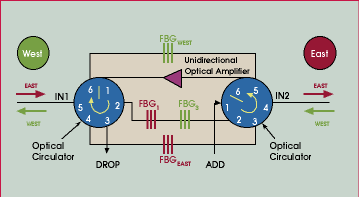
Bidirectional Multiplexer Features Six-Port Circulators
Breck Hitz
Unidirectional optical add/ drop multiplexers are common elements in fiber optic networks, but bidirectional designs have been complex and generally lack flexibility. A team of engineers at the University of Melbourne in Australia recently designed and tested a bidirectional optical add/drop multiplexer that is flexible enough to be used in networks with arbitrary wavelength assignment schemes.
Whether unidirectional or bidirectional, an optical add/drop multiplexer is a critical element of any network. For a unidirectional link between Pittsburgh and Philadelphia, for example, an optical add/drop multiplexer in the middle -- perhaps in Harrisburg, Pa. -- pulls out of the link (drops) those channels going from Pittsburgh to Harrisburg and inserts into the link (adds) the same wavelengths containing information going from Harrisburg to Philadelphia.
The appeal of bidirectional transmission is that in many cases only one fiber would be necessary, thus reducing the cost of installing metro networks. It would not increase a fiber's total bandwidth because the wavelengths traveling in opposite directions would be different. A given fiber would carry only so many channels, whether they were going in one direction or two, but rather than installing two fibers that each would be used to 15 percent of its capacity, a system designer could install a single fiber that would be used to 30 percent of its capacity.

Researchers at the University of Melbourne have demonstrated a bidirectional optical add/drop multiplexer that incorporates six-port optical circulators, fiber Bragg gratings and a unidirectional optical amplifier.
The new bidirectional optical add/drop multiplexer features a pair of six-port optical circulators (see figure). Although six-port circulators are not as readily available as their three-port counterparts, they are well-understood devices. A six-port device accepts radiation through port number N and emits it through port number N+1, so that a signal entering port 1 emerges from port 2, one entering port 2 emerges from port 3, and so on. A signal entering port 6 is absorbed inside the circulator.
Several eastbound channels enter the bidirectional optical add/drop multiplexer's IN1 port. Some of these channels emerge from the drop port, while others emerge from the IN2 port. The dropped eastbound wavelengths enter the add port and emerge from the IN2 port. A symmetric situation exists for a different set of westbound channels entering the IN2 channel.
Although a detailed description of the multiplexer in operation makes it sound like a Rube Goldberg contraption, the rules are simple. First, signals can propagate in only one direction (right to left in the figure) through the unidirectional optical amplifier. Second, FBGWEST in the diagram represents a string of fiber Bragg gratings that reflects the westbound wavelengths, and FBGEAST reflects the eastbound wavelengths. Third, the FBG1 set of fiber Bragg gratings reflects the wavelengths to be dropped from the eastbound channels, and the set labeled FBG3 reflects the dropped westbound wavelengths.
In laboratory tests with three asymmetrically spaced, 10-Gb/s wavelength division multiplexed channels propagating in each direction, the bidirectional optical add/drop multiplexer performed well. Bidirectional gain greater than 13 dB was achieved, in-band crosstalk was down by 45 dB, and out-of-band crosstalk was down by 30 dB. Tests on one of the channels showed a clear eye diagram at a bit error rate of 10-9.
Published: September 2003